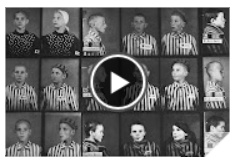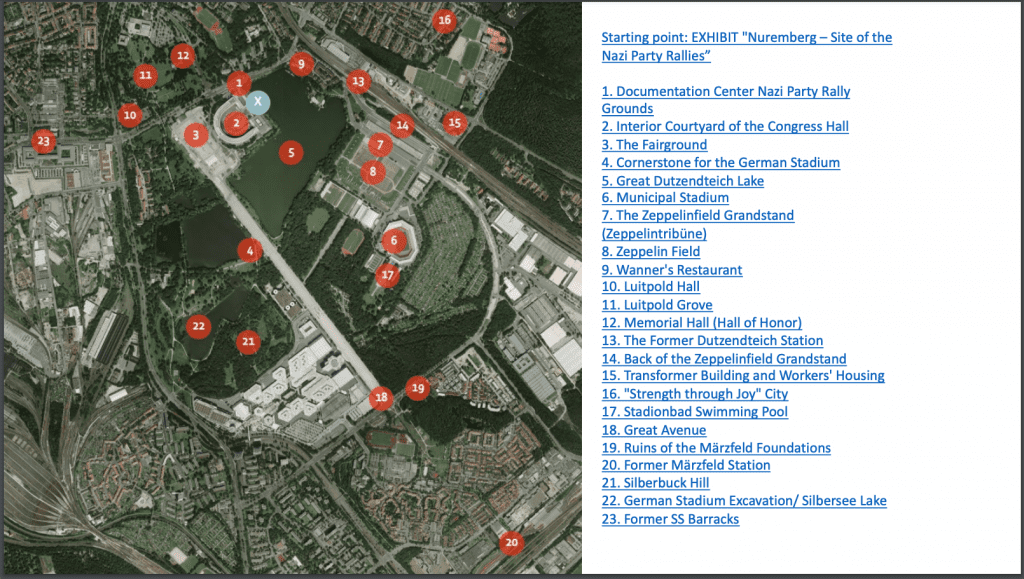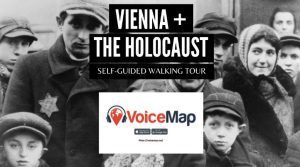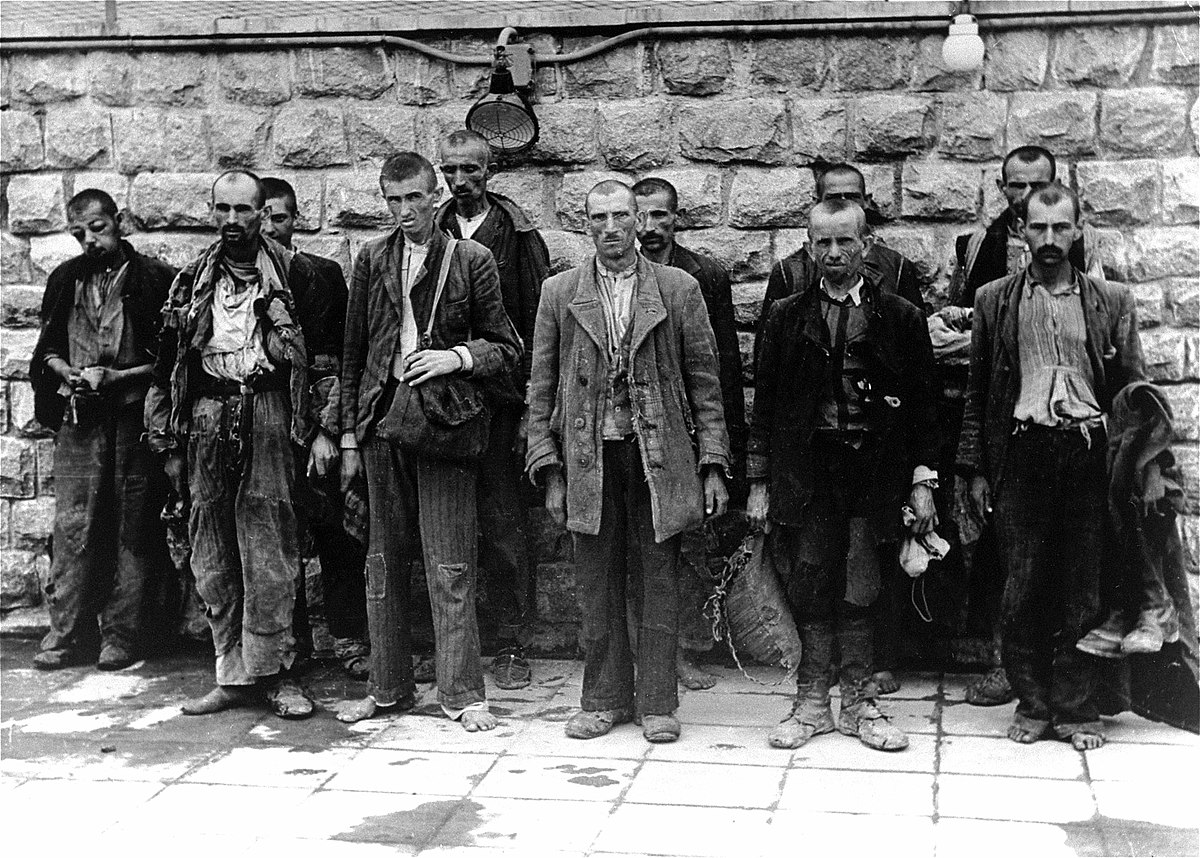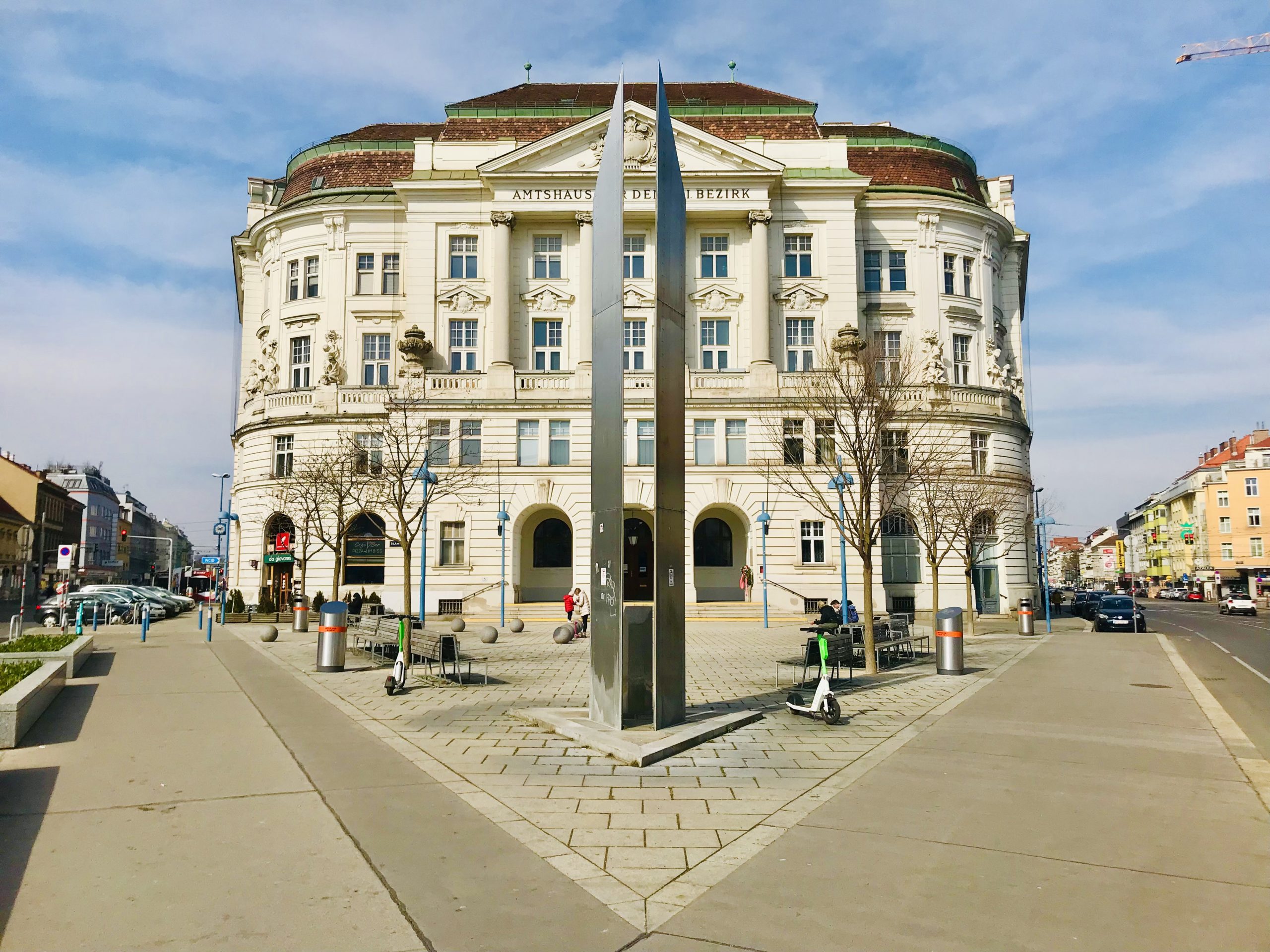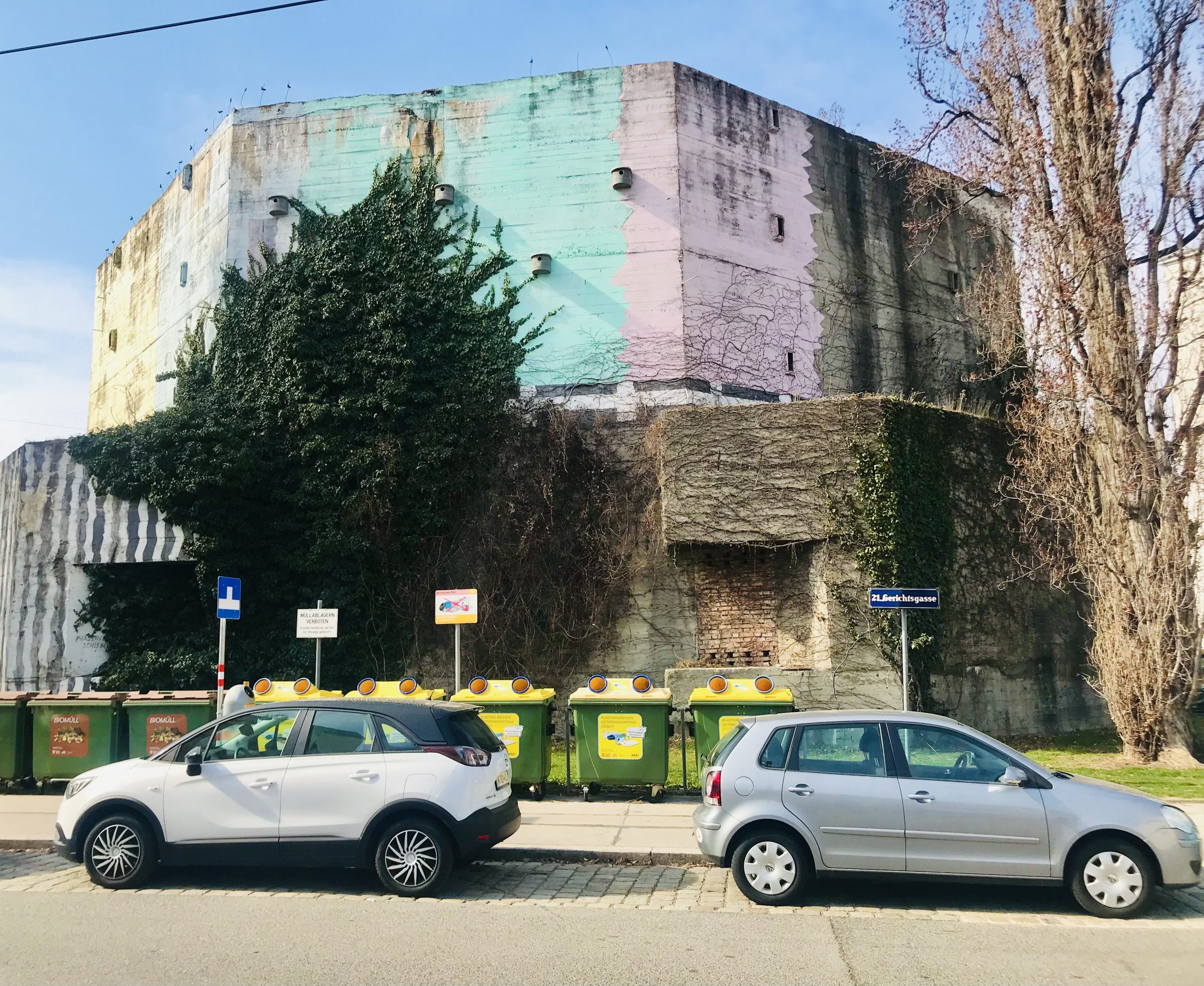
A DESERTED ZEPPELIN AIRFIELD AT THE NUREMBERG RALLY GROUNDS HOSTED ONE OF HISTORY’S MOST EVIL MEN AND HIS ARMY OF DEVOTED FOLLOWERS
Table of Contents
Nestled within a quiet neighborhood on the outskirts of a charming walled medieval city lies a stark reminder of what happens when evil goes unchecked. Today, the Nuremberg Rally Grounds have the semblance of a family-friendly suburban park complete with bicycle paths and a lake. This was a site of fanaticism and hatred. These decaying sites serves as a reminder of what happens when tyranny is allowed to exist. Without a guide to the Nuremberg Rally Grounds, you might not know any better.
Upon closer inspection; however, this peaceful parcel of land (4.25 square miles) in Nuremberg and its abandoned structures were once the epicenter for Hitler and his movement and served as a monumental backdrop for the grandiose events orchestrated by the Nazi Party.
Following Hitler’s declaration that Nuremberg would be the “City of Nazi Party Rallies,” construction began and six rallies were held there between 1933 and 1938. Hitler mandated a neoclassical style and had the final say on any proposed design. Overall, the architectural structures of the Rally Grounds characterize the delusional ambitions of a megalomaniacal dictator and his sycophants.
INFORMATIVE GUIDE TO THE NUREMBERG RALLY GROUNDS
Use our Guide to prepare for your visit to the Nuremberg Rally Grounds. It provides what you need to know, so you can make the most of your visit. The Grounds are enormous and you can easily waste time wandering around. In short, your visit can quickly turn into an overwhelming experience without pro tips and an easy to understand guide. The better prepared you are, the more educational your visit will be. This is a site where evil was on full display. One must understand the past to prevent the same mistakes from happening in the future.
DOCUMENTATION CENTER
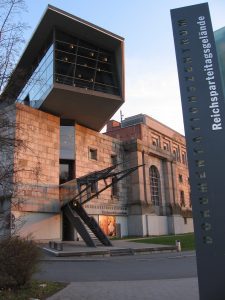 Wikimedia Commons
Wikimedia Commons
NOTE: Currently, there is an interim exhibit while the Documentation Center receives a facelift.
You will want to start your visit here. The “Documentation Center,” a flavorless codeword of sorts for exhibits throughout Germany and Austria that explore the roots of national socialism and the unchecked destruction it unleashed, is an absolute must for anyone interested in, or ignorant of, WWII.
The Documentation Center for the Nuremberg Rally Grounds is housed in the Congress Hall and provides an in-depth history of the root causes and rise of the National Socialist German Workers’ Party (NSDAP, or the Nazi movement). Within the Documentation Center, a permanent exhibition titled “Fascination and Terror” explores the causes, contexts, and consequences of Hitler’s tyranny.
There are 19 chronologically organized exhibits focused on aspects directly related to Nuremberg: the history of the Nazi Party Rallies, the structures at the Rally Grounds, the “Nuremberg Laws” of 1935, and the Nuremberg Trials. In great detail, this exhibit addresses the role of propaganda in promoting National Socialism including director Leni Riefenstahl’s film Triumph of the Will.
The exhibit also provides unique insights into the lives of the average German during this period. Lastly, and most significantly, the exhibit addresses the Holocaust in full detail. The exhibit can best be described as informative, comprehensive and highly objective. Today, the Nuremberg Rally Grounds remain a source of contentious debate between those wanting to preserve the Grounds for educational purposes and those endorsing “controlled decay.”
PRO TIP 1. Start your visit at the Documentation Center. Before entering, review our Guide to the Nuremberg Rally Grounds. Brochures provided by the Documentation Center are confusing and you can quickly become overwhelmed.
PRO TIP 2 – VERY IMPORTANT. Use the audio guide — it is included in the entrance fee. Exhibits are in German and have limited descriptions/context.
PRO TIP 3. Give yourself 2-3 hours to explore the Documentation Center. You will learn what is worth seeing as you explore the Rally Grounds.
PRO TIP 4. To have the best experience, use this interactive Map of the Nuremberg Rally Grounds.
LENI RIEFENSTAHL
Director Leni Riefenstahl (1902-2003) made the film Triumph of the Will at the behest of Adolf Hitler. The film, which is still banned in Germany, depicts Hitler as a superhuman figure, descending into Nuremberg from the air to attend the 700,000 member Nazi Party Rally in 1934. We highly recommend this 20 minute documentary on Leni Reifenstahl.
Riefenstahl remains a controversial figure in history. She pioneered numerous filming techniques and painted herself a neutral artist; however, she was blacklisted after WW2 for her collaboration.
CONGRESS HALL
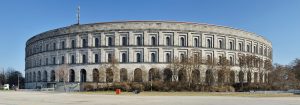 Wikimedia Commons
Wikimedia Commons
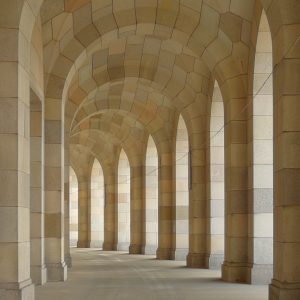 Wikimedia Commons
Wikimedia Commons
The Congress Hall – an incredibly ambitious structure designed by Nazi father and son architects Ludwig and Franz Ruff — was meant to seat 50,000 Party members but was never completed. Other than the annual meeting of Party members, the building had no other purpose. Since 2001, it has housed the Documentation Center for the Nuremberg Rally Grounds. Unfinished and massive in size, the Kongreshalle or Congress hall is the largest remaining building of the Third Reich and was built to house members of the party during their annual Rally in Nuremberg.
The Congress Hall was inspired by the Coliseum in Rome; however, instead of an ellipse, the building was constructed in a “U” or horseshoe shape and was meant to have a self-supporting glass roof so daylight could flood the Hall. A beacon tower and the Nuremberg zoo, opened in 1912, had to be relocated to carry out the designs by architects Ludwig and Franz Ruff. Separately, the swampy ground underneath made elaborate and expensive foundations necessary.
Construction of the Congress Hall started in 1935 . When completed, the Hall would be 820 feet in diameter and 128 feet high. Overall, the Congress Hall was intended to hold twice as many people as the Roman Coliseum. There were 88 pillars situated behind the tribune (the dais or speaking platform) intended to hold the weight of the 25,000-ton roof. In total, 22,000 foundation pillars (52 feet long) were used for the foundation.
Due to the outbreak of war in 1939, construction stopped. After a restart in 1940, there was a short building period before construction ceased altogether. Take time to explore the Congress Hall along the designated route. The immense size of the Hall is a stark reminder of Hitler’s megalomania.
PRO TIP 5. The Congress Hall has a designated route with flat surfaces and elevators are available.
PRO TIP 6 – VERY IMPORTANT. Use the bathroom before you depart the Congress Hall. There are limited facilities outside.
RALLY GROUNDS
The Rally Grounds are massive and signage is somewhat limited and confusing. After taking the Audio Tour and reviewing the interactive Map and Guide of the Nuremberg Rally Grounds, you should be ready to depart the Congress Hall. Here are several tips to save you time.
PRO TIP 7 – VERY IMPORTANT. After exiting the Congress Hall, turn right and walk towards the Silver Lake. Facing the Lake, follow the paved walking path to the LEFT of the Lake. This route will take you directly to the Zeppelin Field. Otherwise, you will spend an additional 45 minutes making your way around the Lake. Remember to bring good walking shoes, water bottles and snacks.
PRO TIP 8 – VERY IMPORTANT. There is little in terms of information throughout the Rally Grounds — you will have no idea what you are looking if you do not tour the Documentation Center or utilize a Guide to the Nuremberg Rally Grounds. The entrance fee includes an audio guide for the permanent exhibition.
PRO TIP 9. The Rally Grounds do not close as they are located outside.
PRO TIP 10 – VERY IMPORTANT. Pay to park your car for the entire day at the Congress Hall. When you are done touring the Rally Grounds, you can take a tram from the Congress Hall (the tram stop was located directly in front of the Congress Hall) to the Nuremberg Courthouse and then to medieval Nuremberg. You can tour all three sites in one day — the Rally Grounds, the Courthouse and medieval Nuremberg — with a combo ticket.
ZEPPELIN FIELD
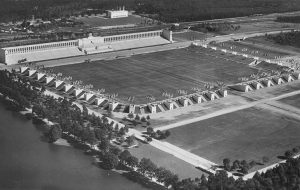 nuremberg municipal archives
nuremberg municipal archives
Perhaps the most easily identifiable structure associated with the rallies is the Zeppelinfeld or Zeppelin Field named after Ferdinand Graf von Zeppelin who landed his airship here in 1909. Designed by “Hitler’s architect” Albert Speer and inspired by the Pergamon Altar, the grandstand at the Zeppelin Field is 1181 feet long.
From his “Führer’s Rostrum” on the grandstand, Hitler delivered virulently anti-Semitic sermons to 200,000 plus seated hypnotized delusional adoring Germans. Another 500,000 Germans would parade through the Zeppelin Field. Huge swastika banners fluttered from 34 surrounding towers in the Zeppelin Field. The monstrous complex, complete with a “cathedral of light” featuring 150 anti-aircraft searchlights pointing skyward (seen 100 miles away in Frankfurt), was immortalized in the German director Leni Riefenstahl’s epic propaganda film Triumph of the Will.
For the Nazis, the Zeppelin Field was the most important event location for their multi-day party rallies and was the ultimate show of power and allegiance. Numerous events were staged on the Zeppelin Field including the roll calls of the Hitler Youth and the Reich Labor Service where tens of thousands of German laborers lined up to salute Hitler. On the Day of Community, young men demonstrated their physical fitness while young women danced and celebrated their roles as future mothers.
Additionally, to celebrate their military might, large parades including troops and Wehrmacht mechanized units were held on the Zeppelin Field. Tanks drove past while anti-aircraft guns fired at airplanes thundering over the field conducting low altitude fly-bys. In 1938, the German prototype of a helicopter landed on the Zeppelin Field.
On 22 April 1945, two days after the Allied victory parade on Nuremberg’s Main Market Square, a second major parade was staged by the U.S. Army on the Zeppelin Field. The parade culminated with the symbolic destruction of the oversized golden swastika above the Zeppelin tribune. U.S. Army soldiers would later paint a large white “A” on a blue circle with a red rim on Hitler’s rostrum – the symbol of the Third Army.
From 1947-1995, the Nuremberg American High School used the Zeppelin field for American football practice. In 1967, the Nuremberg administrators leveled the grandstand’s double row of pillars, causing severe structural damage to the rest of the building.
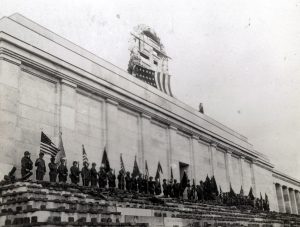 wikimedia commons
wikimedia commons
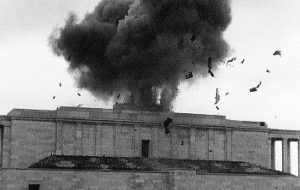 nara.gov
nara.gov
Over the years, the Field has been used for car racing, as a campground, and for concerts. In 1978, Bob Dylan was one of the first major performers to play at the Zeppelin Field. For Dylan, who is of Jewish ancestry, it was a very special moment to play right across from Hitler’s rostrum. Other bands who have performed at the Field include the Rolling Stones, Tina Turner, and Meatloaf as well as the “Monsters of Rock” tour in the 1980s. Today, the Zeppelin Field serves as the home field for the Noris Rams, an American football team in the German premier league.
PRO TIP 11. Climb the stairs and explore the Grandstand — it is allowed.
GOLDEN HALL
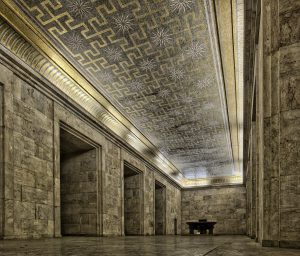 wikimedia commons
wikimedia commons
The Goldened Saal or Golden Hall, named for its gilded ceiling mosaics, was a large elaborately decorated foyer located inside the Zeppelin tribune. Personally designed by Albert Speer, the Hall was completed in 1939. The massive cast iron doors for entering the Hall are positioned above Hitler’s rostrum overlooking the Zeppelin Field. The entrance was directly underneath an oversized golden swastika. Speer envisioned Hitler exiting the Golden Hall from above and then stepping down to address the crowds assembled in the Zeppelin Field. Hitler had other plans.
Highly calculated, Hitler preferred to arrive in his car and entered the grandstand at street level, appearing to emerge from the crowd of his devoted followers. In this way, Hitler staged himself as the Führer who “came from the people.” As a result, Hitler likely never set foot in the Golden Hall, historically known as the Hall of Honor. On 1 September 1939, Germany attacked Poland and started World War II. Interestingly, today the Golden Hall remains the only intact interior planned by Albert Speer.
PRO TIP 12. Tours of the Golden Hall can only be arranged with an official guide from the Documentation Center. Inquire at the information desk.
GERMAN STADIUM
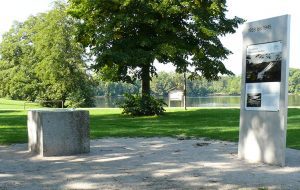 nuremberg municipal archives
nuremberg municipal archives
100 percent Hitler megalomania, Speer’s most ambitious project in Nuremberg was the German Stadium, meant to be the world’s largest stadium. Inspired by the Panathenaic Stadium of Athens, more than 400,000 spectators would attend and partake in the National Socialist Games – a “German Olympics.” The intended shape of the Stadium was a horseshoe containing 3.7 million square feet of space. The proposed dimensions were 2625 feet in length, 1476 feet in width and 400 feet high. A full-sized partial scale model of the Stadium was built on a hillside near Nuremberg to test the integrity of the stands.
The laying of the foundation stone was on 9 July 1937. Speer planned to complete the Stadium for the party congress in 1945. Excavation of the casting pit started in 1938. It was stopped in 1939, but during the entire war, the casting pit had to be kept dry from entering the groundwater. After the war, the northern half of the casting pit filled with water and is now Silbersee (Silver Lake). The southern half of the casting pit was used to deposit the debris of the destroyed downtown Nuremberg. Today you can still see the testing site with several concrete blocks for the stadium.
MUNICIPAL STADIUM
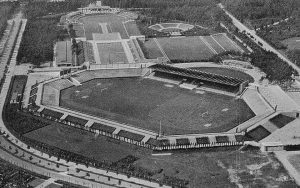 nuremberg municipal archives
nuremberg municipal archives
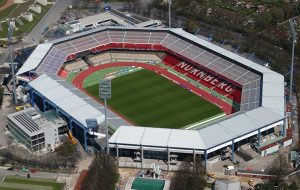 nuremberg municipal archives
nuremberg municipal archives
Built in 1928, the Municipal Stadium still survives and is located adjacent to next to the Zeppelin Field. The Stadium was altered with two wooden towers, expanded entry gates, and the “Führer’s grandstand.” On “Hitler Youth Day,” some 60,000 young people were required to parade through the Stadium in front of the Führer.
THE UMSPANNWERK POWER STATION
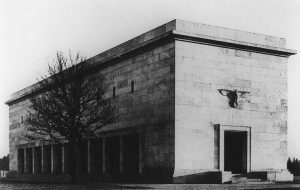 nuremberg municipal archives
nuremberg municipal archives
In 1934, Albert Speer ordered the construction of a power supply station dedicated to the Party Rallies located behind the grandstand on Regensburger Straße. To accommodate the massive influx of Nazi supporters, the power station was specifically built to meet the extreme use of electricity needed to create the Cathedral of Light at the Zeppelin Field. Although today the building is a cafe, the relief of the German eagle, the symbol of the Third Reich, can still be seen today above the main entrance.
PRO TIP 13. This off the beaten path relic of the past is worth investigating.
OUR EXPERIENCE AND THE IMPORTANCE OF HAVING A TRAVEL GUIDE FOR TOURING THE NUREMBERG RALLY GROUNDS
We arrived at the Rally Grounds in the morning and spent close to three hours in the Documentation Center and Congress Hall. We then spent another two hours exploring the Zeppelin Field and other structures. My wife, who is not a WW2 history buff, was engrossed in the exhibits as they contained human interest stories and touched on all aspects of life under Nazi oppression. In addition to reading the information panels, we utilized the English language audio device which gave more in-depth information.
A wise decision, we made the Documentation Center our first stop to set the stage for the rest of the day. This allowed us to bone up on our history and have a greater context for the architecture we were going to see. (Frankly, the provided map for the Nuremberg Rally Grounds was totally overwhelming and we had no idea where to begin.)
The tour of the Documentation Center naturally segues into the Congress Hall. The Hall is massive and it is easy to get overwhelmed. Visitors are only allowed to explore specific portions of the Hall since it was never completed and is likely unsafe in places. After the Documentation Center exhibit, we had a much better idea of which points of interest on the map were worth seeing.
Once you depart the Congress Hall, there is little to no information to give you context for the sites. At the Zeppelin Field, just about everything on the grandstand is climbable/explorable including Hitler’s rostrum. As of this writing, the Golden Hall was only accessible with an official tour guide.
The Rally Grounds are massive and if you head off in the wrong direction (which can easily happen) you can walk aimlessly for miles and waste precious time not seeing anything. Thus, we encourage using our Guide to the Nuremberg Rally Grounds to prepare for your visit.
NEAR THIS PLACE
GUIDE | NUREMBERG PALACE OF JUSTICE. Evil was on trial in courtroom 600 of the Nuremberg Palace of Justice.
TRAVEL GUIDE | ROTHENBURG OB DER TAUBER. Rothenburg, a fairytale Bohemian town of gingerbread buildings surrounded by an impressive medieval wall located along Germany’s Romantic Road.
TRAVE: GUIDE | REGENSBURG. A UNESCO World Heritage Site, Regensburg has the largest preserved medieval old town north of the Alps. Regensburg also has several fine Roman exhibits.
TRAVEL GUIDE | BAMBERG. A UNESCO World Heritage Site, Bamberg is a medieval jewel with an impressive Altes Rathaus (Old Town Hall), and a network of bridges and Old Town.
RELATED TOPICS
VOICEMAP | VIENNA SELF GUIDED WALKING TOUR. Want to learn how the Mossad operation to bring Nazis like Adolf Eichmann to justice originated in Vienna? Check out our VoiceMap self guided walking tour: VIENNA + THE HOLOCAUST: FROM TRAGEDY TO JUSTICE. You can preview it for FREE. Start point is Nestroyplatz on the U1 red line in the 2nd District of Vienna.
BEST PLACES TO STAY
LE MERIDIEN GRAND HOTEL NUREMBERG. Directly opposite Nuremberg Central Station and steps away from the Old Town. Elegant rooms with marble bathrooms and iPod docking stations, sauna, and gym. A great choice for travelers interested in museums, architecture, and atmosphere. ADDRESS: Bahnhofstrasse 1-3, Mitte, 90402 Nuremberg, Germany.
PARK PLAZA NUREMBERG. Newly opened in June 2016 and inspired by Albrecht Dürer and Martin Behaim, the Park Plaza is located in the former home of the Bavarian-American Hotel. Each room features a smartphone. Directly opposite Nuremberg Central Station and steps away from the Old Town. ADDRESS: Bahnhofstraße 5, Mitte, 90402 Nuremberg, Germany.
BIO HOTEL KUNSTQUARTIER. Set in a charming 19th-century building and located in Nürnberg’s Stein district next to the Faber-Castell Art Academy and the Rednitz River. This eco-friendly hotel offers spacious rooms with FREE Wifi and laptop upon request. ADDRESS: Hauptstraße 32-34, 90547 Nuremberg, Germany.
NH COLLECTION NURNBERG CITY. Only a 2-minute walk from the Nuremberg Main Station. Soundproofed rooms with stylish furniture, air conditioning, FREE Wifi, and spa facilities. A great choice for travelers interested in museums, architecture, and atmosphere. ADDRESS: Bahnhofstrasse 17 – 19, Mitte, 90402 Nuremberg, Germany.
ADINA APARTMENT HOTEL NUREMBERG. Centrally located apartments and studios with air conditioning, indoor pool, sauna, fitness center, and FREE Wifi. All units are accessible for the physically disabled. ADDRESS: Dr.-Kurt-Schumacher-Straße 1-7, Mitte, 90402 Nuremberg, Germany.
RESOURCES
Wikipedia: Nazi Party Rally Grounds
The Future of the Nazi Rally Party Grounds
Zeppelin Field: A Place for Learning
BOOKSHELF
![]()



